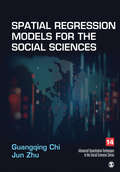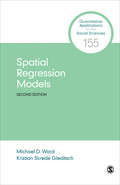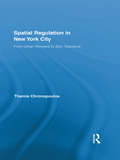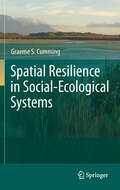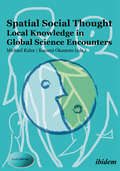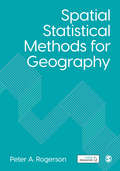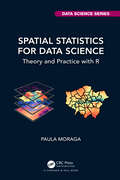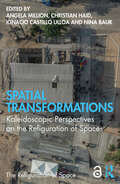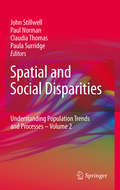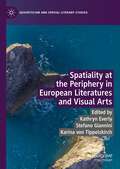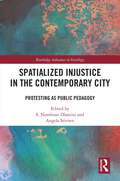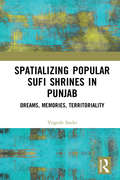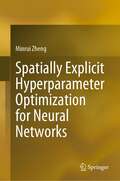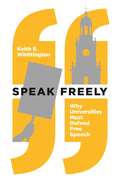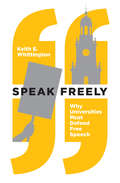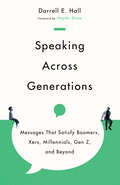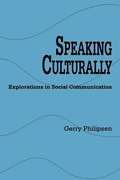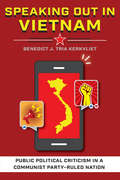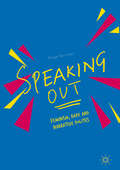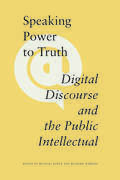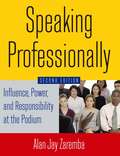- Table View
- List View
Spatial Regression Models for the Social Sciences (Advanced Quantitative Techniques in the Social Sciences #14)
by Jun Zhu Guangqing ChiSpatial Regression Models for the Social Sciences shows researchers and students how to work with spatial data without the need for advanced mathematical statistics. Focusing on the methods that are commonly used by social scientists, Guangqing Chi and Jun Zhu explain what each method is and when and how to apply it by connecting it to social science research topics. Throughout the book they use the same social science example to demonstrate applications of each method and what the results can tell us.
Spatial Regression Models: Spatial Regression Models (Quantitative Applications in the Social Sciences #155)
by Kristian Skrede Gleditsch Michael D. WardSpatial Regression Models illustrates the use of spatial analysis in the social sciences within a regression framework and is accessible to readers with no prior background in spatial analysis. The text covers different modeling-related topics for continuous dependent variables, including mapping data on spatial units, creating data from maps, analyzing exploratory spatial data, working with regression models that have spatially dependent regressors, and estimating regression models with spatially correlated error structures. Using social science examples based on real data, the authors illustrate the concepts discussed, and show how to obtain and interpret relevant results. The examples are presented along with the relevant code to replicate all the analysis using the R package for statistical computing. Users can download both the data and computer code to work through all the examples found in the text. New to the Second Edition is a chapter on mapping as data exploration and its role in the research process, updates to all chapters based on substantive and methodological work, as well as software updates, and information on estimation of time-series, cross-sectional spatial models.
Spatial Regression Models: Spatial Regression Models (Quantitative Applications in the Social Sciences #155)
by Kristian Skrede Gleditsch Michael D. WardSpatial Regression Models illustrates the use of spatial analysis in the social sciences within a regression framework and is accessible to readers with no prior background in spatial analysis. The text covers different modeling-related topics for continuous dependent variables, including mapping data on spatial units, creating data from maps, analyzing exploratory spatial data, working with regression models that have spatially dependent regressors, and estimating regression models with spatially correlated error structures. Using social science examples based on real data, the authors illustrate the concepts discussed, and show how to obtain and interpret relevant results. The examples are presented along with the relevant code to replicate all the analysis using the R package for statistical computing. Users can download both the data and computer code to work through all the examples found in the text. New to the Second Edition is a chapter on mapping as data exploration and its role in the research process, updates to all chapters based on substantive and methodological work, as well as software updates, and information on estimation of time-series, cross-sectional spatial models.
Spatial Regulation in New York City: From Urban Renewal to Zero Tolerance (Routledge Advances in Geography)
by Themis ChronopoulosThis book explores and critiques the process of spatial regulation in post-war New York, focusing on the period after the fiscal crisis of the 1970s, examining the ideological underpinnings and practical applications of urban renewal, exclusionary zoning, anti-vagrancy laws, and order-maintenance policing. It argues that these practices were part of a class project that deflected attention from the underlying causes of poverty, eroded civil rights, and sought to enable real estate investment, high-end consumption, mainstream tourism, and corporate success.
Spatial Resilience in Social-Ecological Systems
by Graeme S. CummingSpatial Resilience is a new and exciting area of interdisciplinary research. It focuses on the influence of spatial variation - including such things as spatial location, context, connectivity, and dispersal - on the resilience of complex systems, and on the roles that resilience and self-organization play in generating spatial variation. Prof. Cumming provides a readable introduction and a first comprehensive synthesis covering the core concepts and applications of spatial resilience to the study of social-ecological systems. The book follows a trajectory from concepts through models, methods, and case study analysis before revisiting the central problems in the further conceptual development of the field. In the process, the author ranges from the movements of lions in northern Zimbabwe to the urban jungles of Europe, and from the collapse of past societies to the social impacts of modern conflict. The many case studies and examples discussed in the book show how the concept of spatial resilience can generate valuable insights into the spatial dynamics of social-ecological systems and contribute to solving some of the most pressing problems of our time. Although it has been written primarily for students, this book will provide fascinating reading for interdisciplinary scientists at all career stages as well as for the interested public. "Graeme Cumming, central in the development of resilience thinking and theory, has produced a wonderful book on spatial resilience, the first ever on this topic. The book will become a shining star, a classic in the explosion of new ideas and approaches to studying and understanding social-ecological systems." Carl Folke, Stockholm Resilience Centre, Sweden
Spatial Social Thought: Local Knowledge in Global Science Encounters
by Michael Kuhn Kazumi OkamotoThis volume presents perspectives on spatially construed knowledge systems and their struggle to interrelate. Western social sciences tend to be wrapped up in very specific, exclusionary discourses, and Northern and Southern knowledge systems are sidelined. Spatial Social Thought reimagines the social sciences as a place of encounter between all spatially bound, parochial knowledge systems.
Spatial Statistical Methods for Geography
by Peter A. RogersonThis accessible new textbook offers a straightforward introduction to doing spatial statistics. Grounded in real world examples, it shows you how to extend traditional statistical methods for use with spatial data. The book assumes basic mathematical and statistics knowledge but also provides a handy refresher guide, so that you can develop your understanding and progress confidently. It also: · Equips you with the tools to both interpret and apply spatial statistical methods · Engages with the unique considerations that apply when working with geographic data · Helps you build your knowledge of key spatial statistical techniques, such as methods of geographic cluster detection.
Spatial Statistical Methods for Geography
by Peter A. RogersonThis accessible new textbook offers a straightforward introduction to doing spatial statistics. Grounded in real world examples, it shows you how to extend traditional statistical methods for use with spatial data. The book assumes basic mathematical and statistics knowledge but also provides a handy refresher guide, so that you can develop your understanding and progress confidently. It also: · Equips you with the tools to both interpret and apply spatial statistical methods · Engages with the unique considerations that apply when working with geographic data · Helps you build your knowledge of key spatial statistical techniques, such as methods of geographic cluster detection.
Spatial Statistics for Data Science: Theory and Practice with R (Chapman & Hall/CRC Data Science Series)
by Paula MoragaSpatial data is crucial to improve decision-making in a wide range of fields including environment, health, ecology, urban planning, economy, and society. Spatial Statistics for Data Science: Theory and Practice with R describes statistical methods, modeling approaches, and visualization techniques to analyze spatial data using R. The book provides a comprehensive overview of the varying types of spatial data, and detailed explanations of the theoretical concepts of spatial statistics, alongside fully reproducible examples which demonstrate how to simulate, describe, and analyze spatial data in various applications. Combining theory and practice, the book includes real-world data science examples such as disease risk mapping, air pollution prediction, species distribution modeling, crime mapping, and real state analyses. The book utilizes publicly available data and offers clear explanations of the R code for importing, manipulating, analyzing, and visualizing data, as well as the interpretation of the results. This ensures contents are easily accessible and fully reproducible for students, researchers, and practitioners. Key Features: Describes R packages for retrieval, manipulation, and visualization of spatial data Offers a comprehensive overview of spatial statistical methods including spatial autocorrelation, clustering, spatial interpolation, model-based geostatistics, and spatial point processes Provides detailed explanations on how to fit and interpret Bayesian spatial models using the integrated nested Laplace approximation (INLA) and stochastic partial differential equation (SPDE) approaches
Spatial Transformations: Kaleidoscopic Perspectives on the Refiguration of Spaces (The Refiguration of Space)
by Angela Million Nina Baur Christian Haid Ignacio Castillo UlloaThis book examines a variety of subjective spatial experiences and knowledge production practices in order to shed new light on the specifics of contemporary socio-spatial change, driven as it is by inter alia, digitalization, transnationalization and migration. Considering the ways in which emerging spatial phenomena are conditioned by an increasing interconnectedness, this book asks how spaces are changing as a result of mediatization, increased mobility, globalization and social dislocation. With attention to questions surrounding the negotiation and (visual) communication of space, it explores the arrangements, spatialities and materialities that underpin the processes of spatial refiguration by which these changes come about. Bringing together the work of leading scholars from across diverse range disciplines to address questions of socio-spatial transformation, this volume will appeal to sociologists and geographers, as well as scholars and practitioners of urban planning and architecture.
Spatial and Social Disparities
by John Stillwell Paul Norman Claudia Thomas Paula SurridgeInequality is one of the major problems of the contemporary world. Significant geographical disparities exist within nations of the developed world, as well as between these countries and those referred to as the 'South' in the Bruntland Report. Issues of equity and deprivation must be addressed in view of sustainable development. However, before policymakers can remove the obstacles to a fairer world, it is essential to understand the nature of inequality, both in terms of its spatial and socio-demographic characteristics. This second volume in the series contains population studies that examine the disparities evident across geographical space in the UK and between different individuals or groups. Topics include demographic and social change, deprivation, happiness, cultural consumption, ethnicity, gender, employment, health, religion, education and social values. These topics and the relationships between them are explored using secondary data from censuses, surveys or administrative records. In volume 1 the findings of research on fertility, living arrangements, care and mobility are examined. Volume 3 will focus on ethnicity and integration.
Spatiality at the Periphery in European Literatures and Visual Arts (Geocriticism and Spatial Literary Studies)
by Kathryn Everly Stefano Giannini Karina Von TippelskirchSpatiality at the Periphery in European Literatures and Visual Arts analyzes the impact migrations, both internal and external, have on Europe’s literary and visual representations in the nineteenth to twenty-first centuries. The volume aims to subvert a centripetal reading of European cultural production by including peripheral thinkers, writers, and visual artists operating in transcultural contexts. The essays highlight and investigate the fertile artistic discourses generated in the spatial peripheries outside of Europe or its inner peripheries. The volume addresses the need for geocritical readings that overcome the engrained dichotomy of centers-peripheries. By doing so, the book brings a more nuanced approach to national literatures and proposes the idea of “contact zones of imaginative interaction”.
Spatialized Injustice in the Contemporary City: Protesting as Public Pedagogy (Routledge Advances in Sociology)
by S. Nombuso DlaminiThis volume documents research illustrating public dissents and interventions to injustice in modern-day cities. Authors present everyday occurrences of city life and place making; still, they show how the ordinary city grows from historical dimensions of injustice, violence and fear. Yet, ordinary citizens continue to make the city their own, to contribute to the creation of city structures and to contest those practices of spatial demarcation, which limit rather than uplift their everyday social livelihood. Chapters show how marginalized populations, from racial, to gendered, to the working poor, are part of the apparatus that makes the city function. However, their contributions to city arrangement and endurance are perpetually at the margins, and city spaces continue to be designed in ways that ignore and negate the existence of those who protest inequity. Novel to the volume are chapters that document and illustrate contestations of city spaces through artistic representation. Public spaces like schools, art galleries and museums are presented as central to projects of inhabiting, remembering and reimagining (in) the just city. Still, ordinary city spaces, like the public washroom, illustrate issues of gender inequity, spatial bias and other art-based protests. City dwellers interested in learning about ‘the making’ of the city; and those interested in the city as a space of possibilities – and the good life, will benefit from this volume. Scholars of geography, space, art and social justice will marvel and simultaneously be appalled by the everyday minute, yet shocking descriptions of the complexity – and unfairly structured city spaces in which they dwell.
Spatializing Popular Sufi Shrines in Punjab: Dreams, Memories, Territoriality
by Yogesh SnehiThis book explores the organic lives of popular Sufi shrines in contemporary Northwest India. It traverses the worldview of shrine spaces, rituals and their complex narratives, and provides an insight into their urban and rural landscapes in the post-Partition (Indian) Punjab. What happened to these shrines when attempts were made to dissuade Sikhs, Muslims and Hindus from their veneration of popular saints in the early twentieth century? What was the fate of popular shrines that persisted even when the Muslim population was virtually wiped off as a result of migration during Partition? How did these shrines manifest in the context of the threat posed by militants in the 1980s? How did such popular practices reconfigure themselves when some important centres of Sufism were left behind in the West Punjab (now Pakistan)? This book examines several of these questions and utilizes a combination of analytical tools, new theoretical tropes and an ethnographic approach to understand and situate popular Sufi shrines so that they are both historicized and spatialized. As such, it lays out some crucial contours of the method and practice of understanding popular sacred spaces (within India and elsewhere), bridging the everyday and the metanarratives of power structures and state formation. This book will be useful to scholars, researchers and those engaged in interdisciplinary work in history, social anthropology, historical sociology, cultural studies, historical geography, religion and art history, as wel as those interested in Sufism and its shrines in South Asia.
Spatially Explicit Hyperparameter Optimization for Neural Networks
by Minrui ZhengNeural networks as the commonly used machine learning algorithms, such as artificial neural networks (ANNs) and convolutional neural networks (CNNs), have been extensively used in the GIScience domain to explore the nonlinear and complex geographic phenomena. However, there are a few studies that investigate the parameter settings of neural networks in GIScience. Moreover, the model performance of neural networks often depends on the parameter setting for a given dataset. Meanwhile, adjusting the parameter configuration of neural networks will increase the overall running time. Therefore, an automated approach is necessary for addressing these limitations in current studies. This book proposes an automated spatially explicit hyperparameter optimization approach to identify optimal or near-optimal parameter settings for neural networks in the GIScience field. Also, the approach improves the computing performance at both model and computing levels. This book is written for researchers of the GIScience field as well as social science subjects.
Speak Freely: Why Universities Must Defend Free Speech (New Forum Bks. #61)
by Keith E. WhittingtonWhy colleges and universities live or die by free speechFree speech is under attack at colleges and universities today, as critics on and off campus challenge the value of freewheeling debate. In Speak Freely, Keith Whittington argues that universities must protect and encourage vigorous free speech because it goes to the heart of their mission to foster freedom of thought, ideological diversity, and tolerance. Examining hot-button issues such as trigger warnings, safe spaces, hate speech, disruptive protests, speaker disinvitations, and the use of social media by faculty, Speak Freely describes the dangers of empowering campus censors to limit speech and enforce orthodoxy. It explains why universities must make space for voices from both the Left and Right. And it points out how better understanding why the university lives or dies by free speech can help guide students, faculty, administrators, and alumni when faced with unpopular, hateful, or dangerous speech. Timely and vitally important, Speak Freely shows why universities can succeed only by fostering more free speech, more free thought—and a greater tolerance for both.
Speak Freely: Why Universities Must Defend Free Speech (New Forum Books #61)
by Keith E. WhittingtonWhy free speech is the lifeblood of colleges and universitiesFree speech is under attack at colleges and universities today, with critics on and off campus challenging the value of open inquiry and freewheeling intellectual debate. Too often speakers are shouted down, professors are threatened, and classes are disrupted. In Speak Freely, Keith Whittington argues that universities must protect and encourage free speech because vigorous free speech is the lifeblood of the university. Without free speech, a university cannot fulfill its most basic, fundamental, and essential purposes, including fostering freedom of thought, ideological diversity, and tolerance. Examining such hot-button issues as trigger warnings, safe spaces, hate speech, disruptive protests, speaker disinvitations, the use of social media by faculty, and academic politics, Speak Freely describes the dangers of empowering campus censors to limit speech and enforce orthodoxy. It explains why free speech and civil discourse are at the heart of the university’s mission of creating and nurturing an open and diverse community dedicated to learning. It shows why universities must make space for voices from both the left and right. And it points out how better understanding why the university lives or dies by free speech can help guide everyone—including students, faculty, administrators, and alumni—when faced with difficult challenges such as unpopular, hateful, or dangerous speech. Timely and vitally important, Speak Freely demonstrates why universities can succeed only by fostering more free speech, more free thought—and a greater tolerance for both.
Speaking Across Generations: Messages That Satisfy Boomers, Xers, Millennials, Gen Z, and Beyond
by Darrell E. HallDifferent generations communicate differently.
Speaking Culturally: Explorations in Social Communication
by Gerry PhilipsenSpeaking Culturally is written to introduce students to the ethnography of communication by presenting a series of cases and commentaries pertaining to speaking.
Speaking Out in Vietnam: Public Political Criticism in a Communist Party–Ruled Nation
by Benedict J. KerkvlietSince 1990 public political criticism has evolved into a prominent feature of Vietnam's political landscape. So argues Benedict Kerkvliet in his analysis of Communist Party–ruled Vietnam. Speaking Out in Vietnam assesses the rise and diversity of these public displays of disagreement, showing that it has morphed from family whispers to large-scale use of electronic media. In discussing how such criticism has become widespread over the last three decades, Kerkvliet focuses on four clusters of critics: factory workers demanding better wages and living standards; villagers demonstrating and petitioning against corruption and land confiscations; citizens opposing China's encroachment into Vietnam and criticizing China-Vietnam relations; and dissidents objecting to the party-state regime and pressing for democratization. He finds that public political criticism ranges from lambasting corrupt authorities to condemning repression of bloggers to protesting about working conditions. Speaking Out in Vietnam shows that although we may think that the party-state represses public criticism, in fact Vietnamese authorities often tolerate and respond positively to such public and open protests.
Speaking Out: Activism and Protest in the 1960s and 1970s
by Heather Ann ThompsonSpeaking Out : Activism and Protest in the 1960s and 1970s is a collection of readings about 21 different activist movements that came of age in the 60s and 70s. Introductions written by recognized scholars who have studied and written about these movements in depth begin each chapter, followed by primary source documents that provide insight into each movement. The chapters not only offer a comprehensive overview of the most important social and political activist groups of these two decades, but they also locate each group’s complex origins, strengths, weaknesses, and legacy. As these authors make clear, ultimately the activist groups of this period each had their share of successes and each made their share of mistakes and miscalculations. Thus, together, they left a most complicated legacy for future generations.
Speaking Out: Feminism, Rape and Narrative Politics
by Tanya SerisierThis is the first critical study of feminist practices of ‘speaking out’ in response to rape. This book argues that feminist anti-rape politics are characterised by a belief in the transformative potential of women’s personal narratives of sexual violence. The political mobilisation of these narratives has been an incredibly successful strategy, but one with unresolved ethical questions and political limitations. The book explores both the successes and the unresolved questions through feminist archival materials, published narratives of sexual violence, and mass media and internet sources. It argues that that a rethinking of the role and place of women’s stories and the politics of speaking out is vital for a rethinking of feminist politics around sexual violence and key to fresh approaches to combating this violence.
Speaking Peace: Women’s Voices from Kashmir
by Urvashi ButaliaThis book reflects the range of women's experiences in the Kashmir conflict, which, for some years, has been a key issue on the Indian political map.
Speaking Power to Truth: Digital Discourse and the Public Intellectual
by Michael Keren Richard HawkinsOnline discourse has created a new media environment for contributions to public life, one that challenges the social significance of the role of public intellectuals—intellectuals who, whether by choice or by circumstance, offer commentary on issues of the day. The value of such commentary is rooted in the assumption that, by virtue of their training and experience, intellectuals possess knowledge—that they understand what constitutes knowledge with respect to a particular topic, are able to distinguish it from mere opinion, and are in a position to define its relevance in different contexts. When intellectuals comment on matters of public concern, they are accordingly presumed to speak truth, whether they are writing books or op-ed columns or appearing as guests on radio and television news programs. At the same time, with increasing frequency, discourse on public life is taking place online. This new digital environment is characterized by abundance—an abundance of speakers, discussion, and access. But has this abundance of discourse—this democratization of knowledge, as some describe it—brought with it a corresponding increase in truth?Casting doubt on the assertion that online discourse, with its proliferation of voices, will somehow yield collective wisdom, Speaking Power to Truth raises concerns that this wealth of digitally enabled commentary is, in fact, too often bereft of the hallmarks of intellectual discourse: an epistemological framework and the provision of evidence to substantiate claims. Instead, the pursuit of truth finds itself in competition with the quest for public reputation, access to influence, and enhanced visibility. But as knowledge is drawn into the orbit of power, and as the line between knowledge and opinion is blurred, what role will the public intellectual play in the promotion and nurturing of democratic processes and goals? In exploring the implications of the digital transition, the contributors to Speaking Power to Truth provide both empirical evidence of, and philosophical reflection on, the current and future role of the public intellectual in a technologically mediated public sphere. With contributions by Karim-Aly Kassam, Barrry Cooper, Jacob G. Foster, Richard Hawkins, Michael Keren, Boaz Miller, Liz Pirnie, and Eleanor Townsley.
Speaking Professionally: Influence, Power and Responsibility at the Podium
by Alan Jay ZarembaUpdated with new and current examples throughout, this concise guide is a rich resource for anyone who wants to become more effective in speaking settings. It covers all the basics and identifies essential principles that will help readers to efficiently prepare, deliver, and evaluate presentations.
